The Chemistry of Living Things
A Comprehensive Guide for IMAT Preparation
I. Introduction: The Chemical Basis of Life
Living organisms are composed of a unique and complex array of molecules, collectively known as biomolecules. These are primarily carbon-based compounds, a consequence of carbon's remarkable ability to form four stable covalent bonds, leading to a vast diversity of structures like chains, branches, and rings. The properties of biomolecules are determined by their carbon skeleton and the attached functional groups (e.g., hydroxyl, carbonyl, carboxyl, amino), which dictate their reactivity and interactions. Life's chemistry is organized around four major classes of macromolecules: carbohydrates, lipids, proteins, and nucleic acids.
II. Carbohydrates: Energy and Structure
Carbohydrates are a major class of biomolecules with the general empirical formula , often called saccharides or sugars. They serve as primary energy sources, energy storage forms, and crucial structural components in living organisms.
A. Monosaccharides: The Simplest Sugars
Monosaccharides are the fundamental building blocks of carbohydrates. They are simple sugars that cannot be broken down into smaller carbohydrate units by hydrolysis. They are classified based on the number of carbon atoms (e.g., trioses, pentoses, hexoses) and the type of carbonyl group they possess: aldoses (aldehyde group) or ketoses (ketone group).
Glucose (), an aldohexose, is a central molecule in cellular metabolism. In aqueous solutions, monosaccharides with five or more carbons, like glucose, exist predominantly in a cyclic form. This occurs when a hydroxyl group reacts with the carbonyl carbon, forming a stable ring structure (a hemiacetal). This cyclization creates a new chiral center at the anomeric carbon (the former carbonyl carbon), resulting in two possible stereoisomers: α-anomers and β-anomers, which differ in the orientation of the hydroxyl group. This distinction is critical for the structure of polysaccharides.
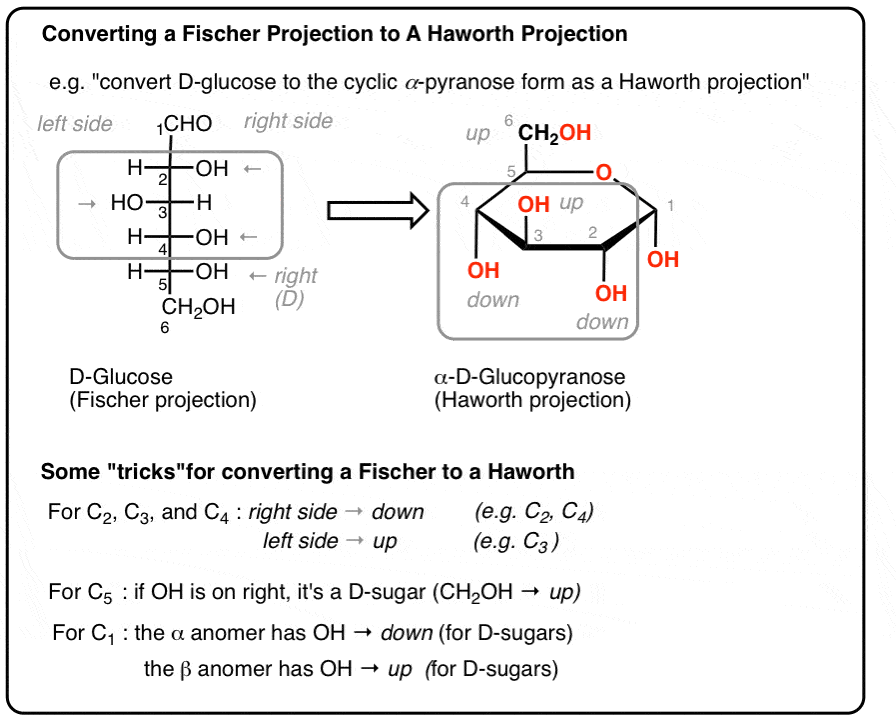
📸 Source/Description: The cyclization of glucose from its linear Fischer projection to its cyclic Haworth projection, forming α and β anomers.
B. Disaccharides: Double Sugars
Disaccharides are formed when two monosaccharides are joined together by a glycosidic bond. This bond is a type of covalent bond formed in a dehydration synthesis (or condensation) reaction, where a molecule of water is removed. The reverse process, hydrolysis, breaks this bond by adding a water molecule.
- Sucrose (table sugar): Composed of glucose and fructose linked by an α-1,β-2 glycosidic bond. Since the anomeric carbons of both monosaccharides are involved in the bond, sucrose is a non-reducing sugar.
- Lactose (milk sugar): Composed of galactose and glucose, linked by a β-1,4 glycosidic bond. It is a reducing sugar.
- Maltose (malt sugar): Composed of two α-glucose units linked by an α-1,4 glycosidic bond. It is a reducing sugar.
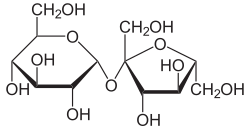
📸 Source/Description: The chemical structure of sucrose, a disaccharide formed from glucose and fructose.
C. Polysaccharides: Complex Carbohydrates
Polysaccharides are polymers composed of many monosaccharide units linked by glycosidic bonds. They serve as large-scale energy storage molecules or as structural components.
Starch
Starch is the primary energy storage polysaccharide in plants. It is a polymer of α-glucose and exists in two forms:
- Amylose: A linear, unbranched polymer where glucose units are linked by α-1,4 glycosidic bonds, causing it to form a helical structure.
- Amylopectin: A branched polymer with a backbone of α-1,4 linked glucose units and branch points formed by α-1,6 glycosidic bonds approximately every 24-30 residues.
Glycogen
Glycogen is the main energy storage polysaccharide in animals, stored primarily in the liver and muscles. It is a polymer of α-glucose, structurally similar to amylopectin but much more highly branched (α-1,6 branches every 8-12 residues). This extensive branching allows for rapid release of glucose monomers when energy is needed.
Cellulose
Cellulose is the most abundant structural polysaccharide, forming the primary component of plant cell walls. It is an unbranched, linear polymer of β-glucose units linked by β-1,4 glycosidic bonds. This linkage causes the chains to be straight and rigid. Parallel cellulose chains form strong hydrogen bonds with each other, creating tough, insoluble microfibrils that provide excellent structural support. Humans lack the enzyme to digest β-1,4 linkages, so cellulose acts as dietary fiber.

📸 Source/Description: The β-1,4 glycosidic linkages in cellulose create long, straight chains ideal for structural support.
| Table 1: Comparison of Key Polysaccharides | |||
|---|---|---|---|
| Feature | Starch | Glycogen | Cellulose |
| Monomer Unit | α-glucose | α-glucose | β-glucose |
| Glycosidic Linkage(s) | α-1,4 and α-1,6 | α-1,4 and α-1,6 | β-1,4 |
| Branching | Moderately branched (amylopectin) | Highly branched | Unbranched (Linear) |
| Primary Function | Energy storage in plants | Energy storage in animals | Structural support in plants |
| 3D Shape | Helical | Helical with extensive branches | Linear chains forming fibrils |
| Digestibility by Humans | Yes | (Synthesized in body) | No (Dietary fiber) |
III. Lipids: Diverse Roles in Energy, Membranes, and Signaling
Lipids are a diverse group of hydrophobic (water-fearing) biomolecules that are soluble in nonpolar organic solvents. Unlike other macromolecules, they are not true polymers. They play crucial roles in long-term energy storage, membrane structure, insulation, and signaling.
A. Triglycerides (Fats and Oils)
Triglycerides are esters formed from one molecule of glycerol and three fatty acid molecules via ester linkages. Fatty acids are long hydrocarbon chains with a terminal carboxyl group. They can be:
- Saturated: No double bonds in the hydrocarbon chain. The chains are straight, allowing molecules to pack tightly, resulting in solids at room temperature (e.g., butter, lard).
- Unsaturated: One or more double bonds in the chain. The double bonds (usually in *cis* configuration) create kinks, preventing tight packing and resulting in liquids at room temperature (e.g., olive oil).

📸 Source/Description: A triglyceride is formed by the esterification of one glycerol molecule with three fatty acids.
B. Phospholipids
Phospholipids are the primary components of cell membranes. They are structurally similar to triglycerides, but one fatty acid is replaced by a phosphate group, which is often attached to another small polar group. This structure makes the molecule amphipathic: it has a hydrophilic (water-loving) phosphate head and two hydrophobic (water-fearing) fatty acid tails. In water, phospholipids spontaneously self-assemble into a bilayer, with the hydrophobic tails facing inward and the hydrophilic heads facing outward, forming a stable barrier.

📸 Source/Description: The amphipathic nature of phospholipids drives the formation of the cell membrane's bilayer structure.
C. Steroids
Steroids are lipids characterized by a distinctive four-ring carbon skeleton. They are functionally very different from other lipids. Cholesterol is a vital steroid in animals; it is a precursor for many other steroids, including steroid hormones (like testosterone and estrogen) and bile acids. It is also an essential component of animal cell membranes, where it helps regulate membrane fluidity.

📸 Source/Description: The characteristic four-fused-ring structure of the steroid backbone, found in cholesterol and steroid hormones.
IV. Proteins: The Workhorses of the Cell
A. Amino Acids: The Building Blocks
Proteins are polymers made up of monomeric units called amino acids, linked in a specific sequence. There are 20 common amino acids found in proteins. Each amino acid has a central carbon atom (α-carbon) bonded to an amino group (), a carboxyl group (), a hydrogen atom, and a variable side chain known as the R group. The chemical properties of the R group determine the unique characteristics of each amino acid (e.g., nonpolar, polar, acidic, or basic) and are crucial for protein structure and function.
📸 Source/Description: The general structure of an amino acid, highlighting the central alpha-carbon and the variable R group.
B. Peptide Bonds and Polypeptides
Amino acids are linked together by peptide bonds to form polypeptide chains. A peptide bond is an amide linkage formed in a dehydration reaction between the carboxyl group of one amino acid and the amino group of another. This bond is rigid and planar, which constrains the conformation of the polypeptide backbone. A chain of amino acids is called a polypeptide, and a functional protein may consist of one or more polypeptide chains.

📸 Source/Description: Two amino acids join via a dehydration reaction to form a peptide bond, releasing a water molecule.
C. Levels of Protein Structure
The functionality of a protein is dictated by its intricate three-dimensional structure, which is organized hierarchically into four levels:
- Primary Structure (1°): The unique linear sequence of amino acids in a polypeptide chain, determined by genetic information.
- Secondary Structure (2°): Local folding of the polypeptide backbone into regular, repeating patterns, stabilized by hydrogen bonds between C=O and N-H groups of the backbone. The most common types are the α-helix (a spiral) and the β-pleated sheet (folded strands).
- Tertiary Structure (3°): The overall three-dimensional shape of a single polypeptide chain. It is stabilized by various interactions between the R groups of the amino acids, including hydrophobic interactions, hydrogen bonds, ionic bonds, and covalent disulfide bridges between cysteine residues.
- Quaternary Structure (4°): The arrangement of two or more polypeptide chains (subunits) to form a single functional protein. An example is hemoglobin, which consists of four subunits. Not all proteins have quaternary structure.
The specific 3D conformation of a protein is absolutely critical for its biological function. The process of a protein losing its native structure is called denaturation, which can be caused by changes in temperature, pH, or exposure to certain chemicals, typically resulting in a loss of function.
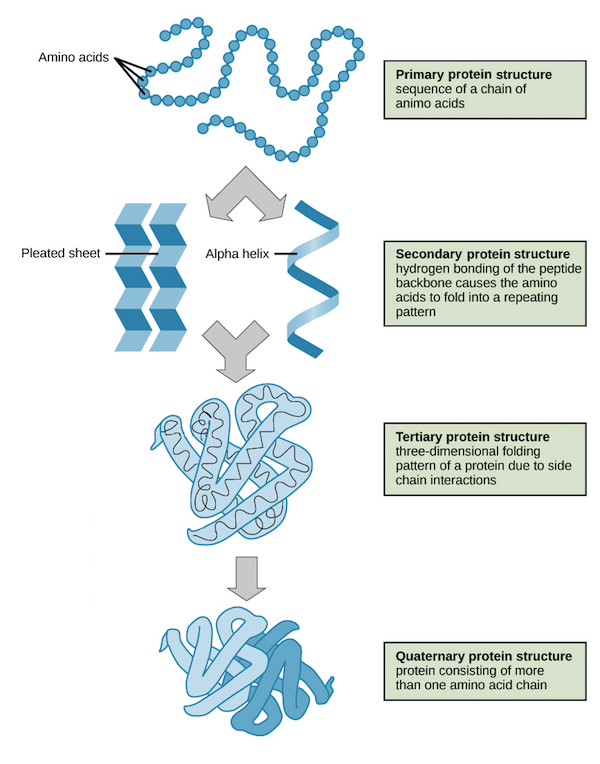
📸 Source/Description: The four hierarchical levels of protein structure: primary, secondary, tertiary, and quaternary.
| Table 3: Key Protein Functions with Examples | ||
|---|---|---|
| Function | Description | Example(s) |
| Enzymatic Catalysis | Accelerate the rate of biochemical reactions. | Amylase, DNA polymerase, Pepsin |
| Structural Support | Provide physical support and shape to cells and tissues. | Collagen (connective tissue), Keratin (hair, nails) |
| Transport | Carry substances within the body or across cell membranes. | Hemoglobin (transports O₂), Glucose transporters |
| Hormonal Signaling | Act as chemical messengers to coordinate bodily functions. | Insulin, Glucagon, Growth hormone |
| Movement | Mediate muscle contraction and cellular movement. | Actin and Myosin |
| Immune Defense | Recognize and neutralize foreign pathogens. | Antibodies (Immunoglobulins) |
V. Nucleic Acids: Information Storage and Transfer
Nucleic acids are polymers specialized for the storage, transmission, and expression of genetic information. There are two main types: deoxyribonucleic acid (DNA) and ribonucleic acid (RNA).
A. Nucleotides: The Monomers
Nucleotides are the monomeric building blocks of nucleic acids. Each nucleotide consists of three components: a pentose sugar (deoxyribose in DNA, ribose in RNA), a phosphate group (attached to the 5' carbon of the sugar), and a nitrogenous base (attached to the 1' carbon). The bases are either purines (Adenine [A], Guanine [G]) or pyrimidines (Cytosine [C], Thymine [T] in DNA, Uracil [U] in RNA).
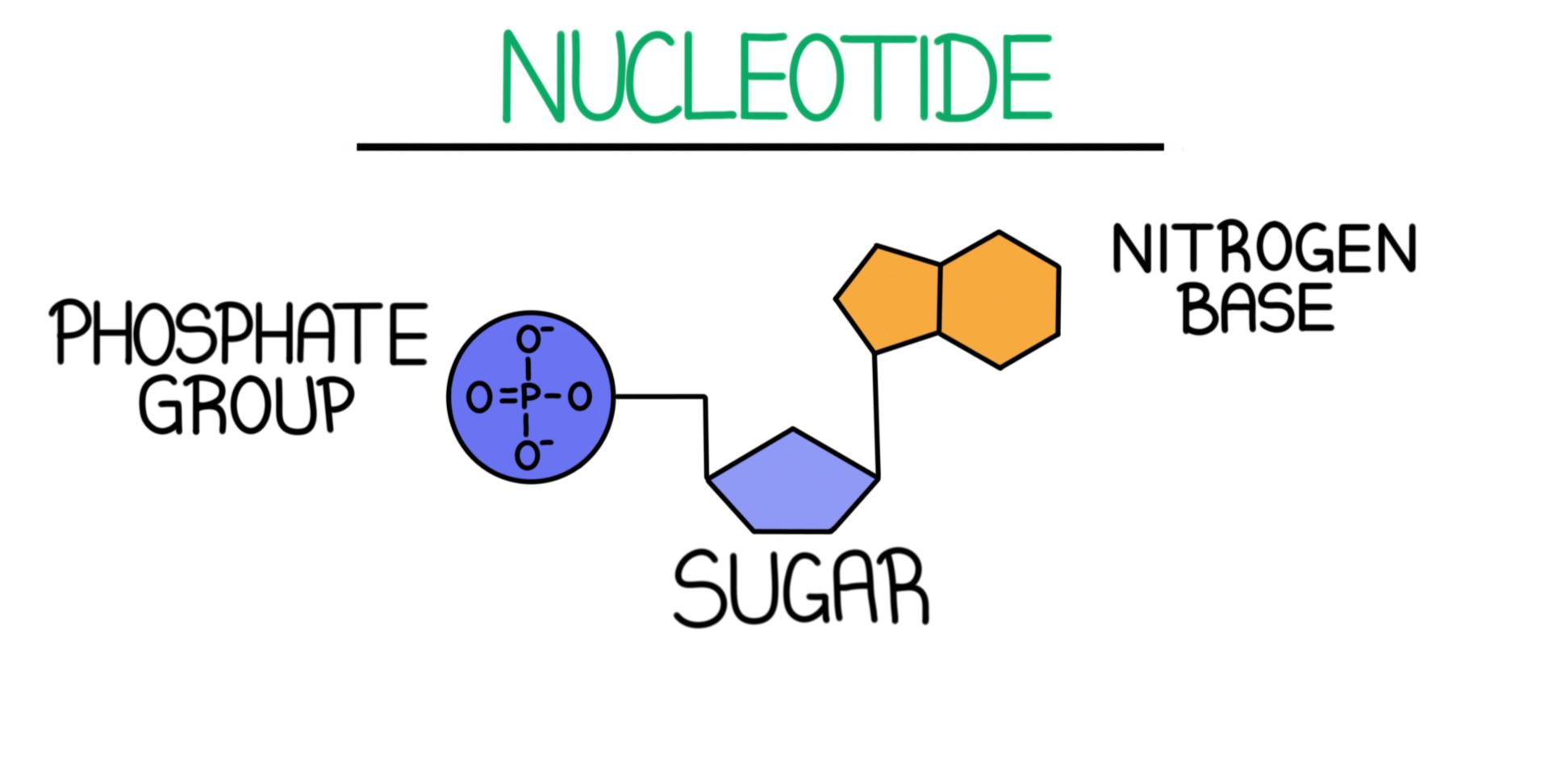
📸 Source/Description: A DNA nucleotide, composed of a phosphate group, a deoxyribose sugar, and a nitrogenous base.
B. Deoxyribonucleic Acid (DNA)
DNA is the primary repository of genetic information. Nucleotides are linked by phosphodiester bonds between the 3' carbon of one sugar and the 5' carbon of the next, forming a sugar-phosphate backbone. DNA typically exists as a double helix, consisting of two antiparallel strands (running in opposite 5' to 3' directions). The strands are held together by hydrogen bonds between complementary bases: Adenine pairs with Thymine (A-T) via two hydrogen bonds, and Guanine pairs with Cytosine (G-C) via three hydrogen bonds.

📸 Source/Description: The antiparallel strands of the DNA double helix are held together by specific hydrogen bonding between complementary bases.
C. Ribonucleic Acid (RNA)
RNA plays diverse roles in translating genetic information from DNA into proteins. It contains ribose sugar, the base Uracil (U) instead of Thymine, and is typically single-stranded. This single-stranded nature allows RNA to fold into complex three-dimensional structures.
- Messenger RNA (mRNA): Carries genetic code from the DNA in the nucleus to the ribosome.
- Transfer RNA (tRNA): Carries specific amino acids to the ribosome during protein synthesis.
- Ribosomal RNA (rRNA): A major structural and catalytic component of ribosomes.
| Table 4: Comparison of DNA and RNA | ||
|---|---|---|
| Feature | DNA | RNA |
| Sugar | Deoxyribose (lacks -OH at 2' C) | Ribose (has -OH at 2' C) |
| Bases | Adenine (A), Guanine (G), Cytosine (C), Thymine (T) | Adenine (A), Guanine (G), Cytosine (C), Uracil (U) |
| Structure | Double-stranded helix, antiparallel | Usually single-stranded, can form complex 3D shapes |
| Primary Function | Long-term storage of genetic information | Protein synthesis, gene regulation, enzymatic activity |
| Stability | More stable (due to deoxyribose and double helix) | Less stable, more reactive (due to ribose's 2'-OH group) |
VI. Water: The Solvent of Life
Water () is the most abundant molecule in living organisms and is essential for all known life, primarily due to its unique chemical properties derived from its polarity and ability to form hydrogen bonds.
A. Structure, Polarity, and Hydrogen Bonding
A water molecule consists of one highly electronegative oxygen atom covalently bonded to two hydrogen atoms in a bent shape. This creates a polar molecule with partial negative charge on the oxygen and partial positive charges on the hydrogens. This polarity allows water molecules to form hydrogen bonds with each other and with other polar molecules.
B. Emergent Properties Crucial for Life
- Excellent Solvent: Its polarity allows it to dissolve a wide range of polar and ionic substances ("like dissolves like"), making it the universal solvent for biochemical reactions.
- Cohesion and Adhesion: Cohesion (water molecules sticking together) leads to high surface tension, while adhesion (water sticking to other surfaces) allows for capillary action, essential for water transport in plants.
- High Specific Heat Capacity: Water can absorb a large amount of heat with only a small change in its own temperature. This helps organisms maintain a stable internal temperature.
- High Heat of Vaporization: A large amount of heat is required to turn liquid water into vapor, a property utilized in evaporative cooling (e.g., sweating).
- Density Anomaly: Solid water (ice) is less dense than liquid water because hydrogen bonds form a crystalline lattice that spaces the molecules farther apart. This allows ice to float, insulating aquatic environments in winter.
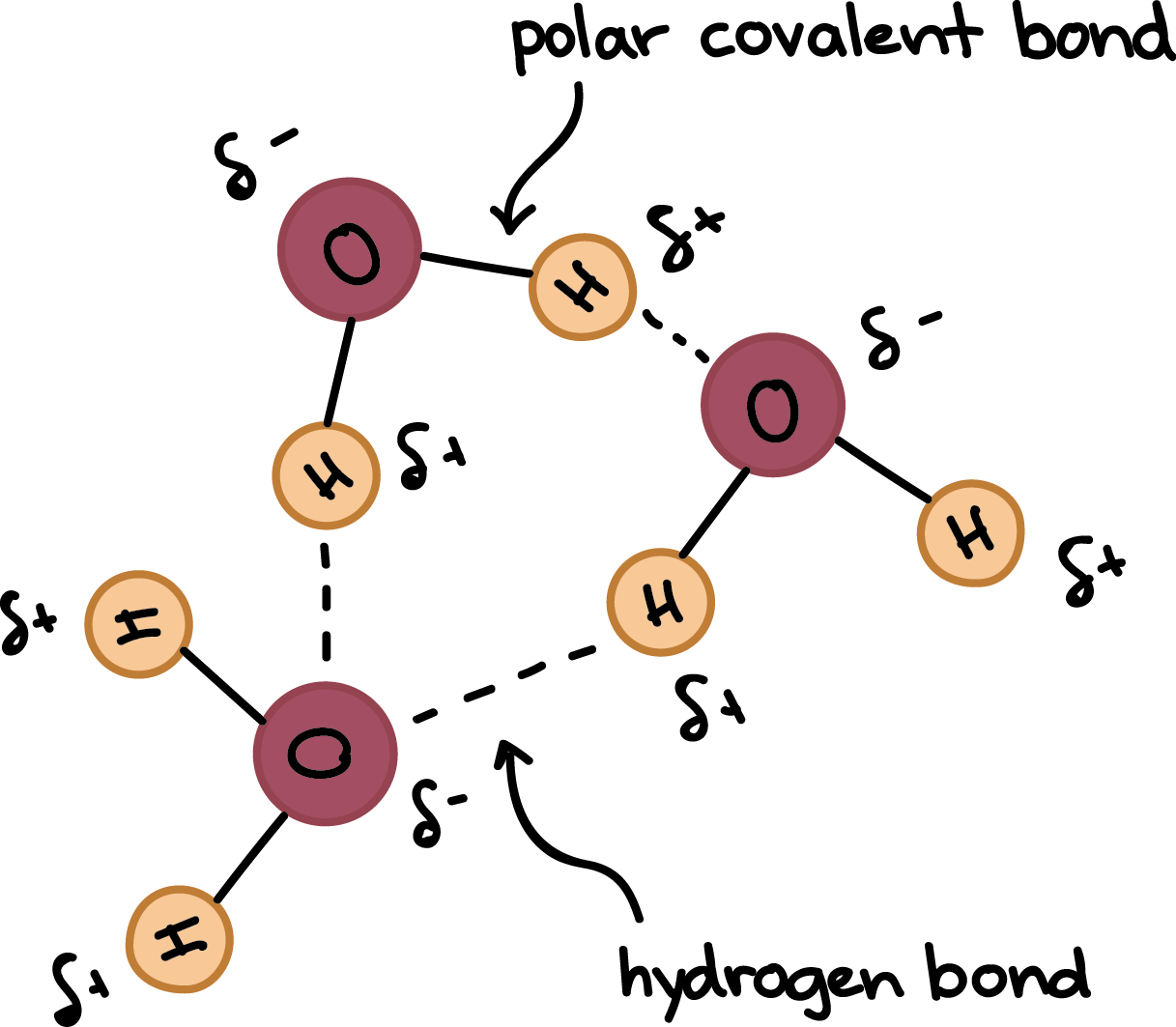
📸 Source/Description: The polarity of water molecules leads to the formation of hydrogen bonds, which are responsible for many of its life-sustaining properties.
VII. Key Takeaways for IMAT Preparation
For success in the IMAT biology and chemistry sections concerning "The Chemistry of Living Things," a deep understanding of the following core concepts is essential:
- Structure Dictates Function: This is the central theme. Understand how a molecule's structure (e.g., α vs. β linkages in glucose, R-groups in amino acids, saturated vs. unsaturated fatty acids) determines its biological role.
- Monomers and Polymers: Memorize the building blocks for each class (monosaccharides, amino acids, nucleotides, fatty acids/glycerol) and the specific covalent bonds that link them (glycosidic, peptide, phosphodiester, ester bonds).
- Key Examples and Their Roles: Be intimately familiar with the structure and function of glucose, glycogen, starch, cellulose, phospholipids, cholesterol, hemoglobin, DNA, and RNA.
- Critical Comparisons: Be prepared to differentiate between related molecules and concepts (e.g., starch vs. glycogen vs. cellulose; DNA vs. RNA; saturated vs. unsaturated fats; α-helix vs. β-sheet).
- Water's Centrality: Appreciate how water's polarity and hydrogen bonding give rise to its unique emergent properties that are indispensable for life.